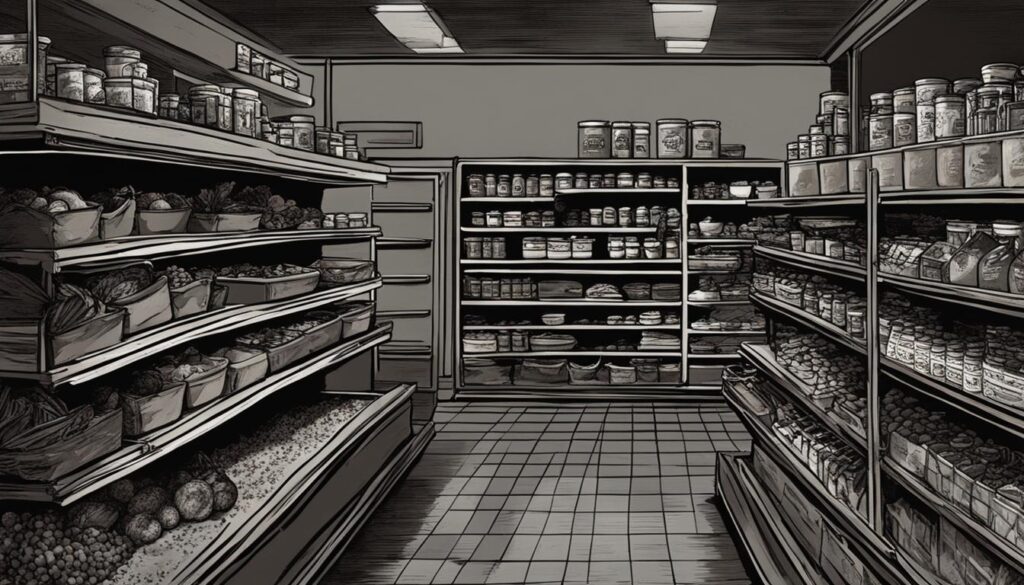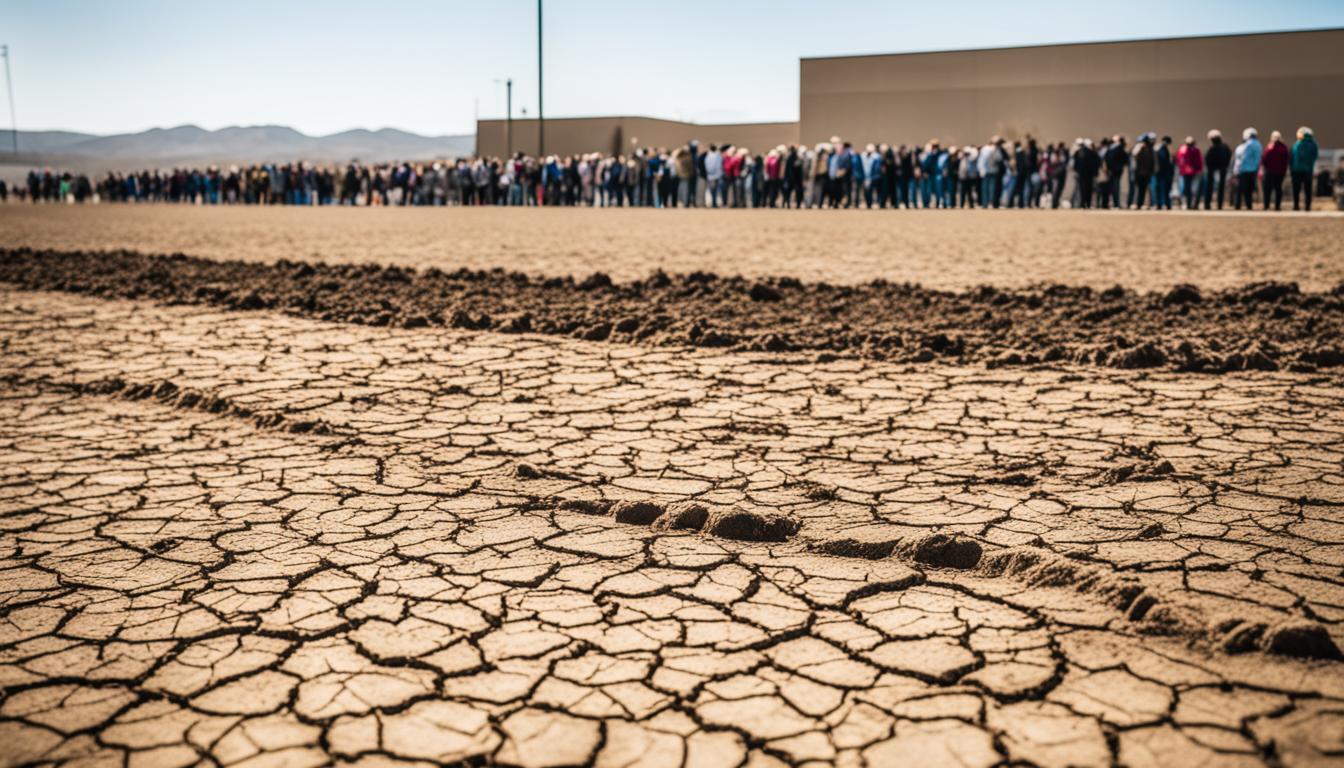Food shortage, global food shortage, food insecurity, food crisis, food scarcity, hunger crisis, famine, food supply, food production, food distribution – these are all phrases that highlight the pressing issue affecting millions of people worldwide.
In the United States alone, over 10% of the population struggles with food insecurity, with approximately 38.3 million Americans experiencing uncertainty regarding their next meal.
This article aims to explore the causes and potential solutions of this alarming problem, shedding light on topics such as the definition of food insecurity, its impact on society, and the various groups that are most affected.
Giving Food Insecurity a Definition
Food security, as defined by the USDA, is “access by all people at all times to enough food for a healthy life.” Therefore, food insecurity occurs when individuals or families do not have access or cannot afford enough quality food.
The USDA provides four categories to understand different experiences of food security and food insecurity:
- High food security: Individuals or households have no issues accessing adequate food nor compromise the quality of their diet.
- Marginal food security: At times, the quantity, variety, or quality of food is reduced due to financial constraints.
- Low food security: Individuals or households face reduced food intake or disrupted eating patterns, resulting in reduced diet quality.
- Very low food security: Severe compromise in food intake and disrupted eating patterns, leading to multiple indicators of disrupted eating patterns and reduced food intake.
Understanding these categories helps in assessing the level of food security and identifying areas where interventions and support are required to address food insecurity.

| Category | Definition |
|---|---|
| High food security | Access to adequate food without compromising the quality of the diet. |
| Marginal food security | Some compromises in quantity, variety, or quality of food due to financial constraints. |
| Low food security | Reduced food intake or disrupted eating patterns leading to a decline in the quality of the diet. |
| Very low food security | Severe compromise in food intake and disrupted eating patterns, resulting in multiple indicators of disrupted eating and reduced food intake. |
Who is Food Insecure?
While food insecurity affects communities of all backgrounds, certain groups are more impacted than others. Children are particularly vulnerable, with 11.7 million children in the United States experiencing food insecurity.
In addition, households composed of Black or Hispanic families or individuals face a higher risk of food insecurity. These communities, which have historically faced systemic oppression and poverty, are disproportionately affected by food insecurity.

Food Insecurity Impact on Children
Children experiencing food insecurity face numerous challenges that can have lasting effects on their well-being. Hunger negatively impacts their physical and mental development, compromising their ability to thrive. It can lead to increased risk of chronic illnesses, weakened immune systems, and impaired learning outcomes.
Disproportionate Effect on Black and Hispanic Communities
The Black and Hispanic communities bear a heavier burden in the face of food insecurity. Historical inequalities, coupled with systemic oppression and poverty, have created barriers to food access, leaving these communities at greater risk. Addressing these disparities is crucial in creating a more equitable and sustainable food system.
| Group | Food Insecurity Rate |
|---|---|
| Black | XX% |
| Hispanic | XX% |
| White | XX% |
What Causes Food Insecurity?
Food insecurity is a complex issue that stems from various factors, including poverty, geography, transportation, and low wages. Let’s explore each of these causes in more detail:
Poverty
Poverty is the primary cause of food insecurity. With approximately 38.3 million Americans struggling to afford enough quality food, poverty fuels the cycle of inadequate access to nutrition. Low-income households often allocate a significant portion of their earnings towards meeting their basic food needs.
Geography and Urban Planning
Geography plays a role in exacerbating food insecurity, especially in areas designated as “food deserts.” These are regions where affordable and accessible grocery stores are scarce.
Limited transportation options, long distances to supermarkets, and inadequate public transportation systems make it challenging for individuals in these areas to access nutritious food options. Addressing geographical barriers is crucial in ensuring food security for all communities.
Low Wages
Low wages contribute to food insecurity by limiting individuals’ purchasing power and making it difficult to afford an adequate and nutritious diet. Many working individuals and families struggle to make ends meet, often having to choose between paying for housing, medical expenses, or buying enough food. Increasing the minimum wage and promoting fair wages can help alleviate this issue.
Let’s take a closer look at the causes of food insecurity:
| Causes | Description |
|---|---|
| Poverty | 38.3 million Americans unable to afford enough quality food |
| Geography and Urban Planning | “Food deserts” lacking affordable and accessible grocery stores |
| Low Wages | Limited purchasing power and difficulty in affording nutritious diet |

The Impact of Food Insecurity
Food insecurity has a profound impact on individuals and society as a whole. It not only affects access to food but also has far-reaching consequences for various aspects of people’s lives.
Struggles with Budgeting and Prioritizing Expenses
Households experiencing food insecurity often face the challenging task of budgeting and prioritizing their expenses. With limited resources, individuals and families must make difficult choices between purchasing food, paying for housing, and accessing healthcare. This financial strain can lead to increased stress and anxiety, further exacerbating the impact of food insecurity.
Adverse Health Outcomes
Food insecurity is closely linked to negative health outcomes. Individuals who experience food insecurity have a higher risk of developing chronic diseases such as diabetes, obesity, and depression.
Inadequate access to nutritious food and the reliance on high-calorie, low-nutrient options contribute to these health issues. Addressing food insecurity is essential in promoting better health outcomes for vulnerable populations.
Effects on Children
Children who experience food insecurity are particularly vulnerable to long-term consequences. Insufficient access to nutritious meals can result in developmental problems, weakened immune systems, and impaired learning outcomes.
Adequate nutrition is crucial for children’s growth, cognitive development, and overall well-being. Therefore, addressing food insecurity is vital to ensuring a brighter future for our children.

| Impact of Food Insecurity | Statistics/Research Findings |
|---|---|
| Poor academic performance | Children experiencing food insecurity are more likely to struggle academically compared to their food-secure peers. |
| Increased healthcare costs | Individuals facing food insecurity often delay or forgo medical care, leading to higher healthcare costs in the long run. |
| Mental health issues | Food insecurity is associated with higher rates of Mental health issues, including depression and anxiety. |
| Reduced productivity | Adults experiencing food insecurity may struggle to focus at work, resulting in decreased productivity and economic stability. |
Addressing food insecurity is not only a matter of basic need but also crucial for the overall well-being of individuals, families, and society. By implementing comprehensive solutions, we can create a future where everyone has access to nutritious food and the opportunity to thrive.
Solutions to Ending Food Insecurity
Addressing food insecurity requires systemic changes and targeted solutions. By implementing effective strategies, we can work towards a future where everyone has access to nutritious and affordable food. Here are some key solutions that can make a significant difference:
Modernizing SNAP Benefits
A crucial step in combating food insecurity is to modernize SNAP (Supplemental Nutrition Assistance Program) benefits. SNAP provides assistance to low-income individuals and families, but the amount of support needs to be adequate for them to afford nutritious food. By updating and improving the SNAP program, we can ensure that it truly meets the needs of those who rely on it.
Reducing Food Waste
A significant portion of the food supply goes to waste each year, exacerbating food insecurity. To address this issue, there is a need for comprehensive efforts to reduce food waste at various levels of the food system.
Implementing consistent labeling conventions and educating consumers on food storage and proper utilization can contribute to minimizing waste. Furthermore, protecting grocery retailers that donate surplus food can encourage more donations and help divert excess food to those in need.
Free School Lunches
Providing free school lunches to all students is an effective way to improve access to nutritious meals and support better learning outcomes. This ensures that children from low-income families have access to at least one nutritious meal per day, reducing their vulnerability to food insecurity. By investing in universal free school lunch programs, we can prioritize the well-being and development of our future generations.
| Solution | Description |
|---|---|
| Modernizing SNAP Benefits | Updating and improving the SNAP program to ensure adequate support for individuals and families. |
| Reducing Food Waste | Implementing consistent labeling conventions, educating consumers, and protecting grocery retailers to minimize food waste. |
| Free School Lunches | Providing free nutritious meals to all students, regardless of income, to address food insecurity and improve learning outcomes. |
By embracing these solutions and working together, we can make meaningful progress in ending food insecurity. It is essential to prioritize the well-being of individuals and communities, ensuring that everyone has access to the food they need for a healthy and prosperous life.
Importance of Sustainable Agriculture
Sustainable agriculture plays a vital role in addressing long-term food insecurity. By implementing practices such as crop rotation, community-supported agriculture, and AgTech initiatives, we can make significant strides in ensuring food security for present and future generations.
Crop Rotation: Nurturing Soil Health
Crop rotation is a sustainable agricultural practice that involves growing different crops in a sequence on a particular piece of land. This method helps replenish soil nutrients naturally, promoting healthier plant growth and reducing the reliance on synthetic fertilizers.
By rotating crops, farmers can also minimize pest and disease pressures, leading to reduced pesticide use. This sustainable approach not only preserves the long-term fertility of the soil but also contributes to more resilient and productive agricultural systems.
Community-Supported Agriculture: Fostering Local Connections
Community-supported agriculture (CSA) is a collaborative model where consumers purchase shares from local farmers before the growing season begins. Throughout the season, shareholders receive regular deliveries of fresh, locally grown produce.
By participating in CSA programs, consumers directly support local farmers and contribute to the vitality of their communities. CSA not only fosters sustainable agriculture but also strengthens local food systems, promotes seasonal eating, and encourages the consumption of nutritious, locally sourced foods.
AgTech Initiatives: Harnessing Innovation for Food Security
In an era of technological advancement, AgTech initiatives have emerged as powerful tools for boosting agricultural productivity and efficiency. Through the application of innovative technologies such as precision farming, vertical farming, and hydroponics, AgTech aims to optimize resource utilization, increase yields, and reduce environmental impact.
These solutions hold great potential in addressing food insecurity by enhancing agricultural production and maximizing the use of limited resources.
| Benefits of Sustainable Agriculture | Examples |
|---|---|
| Preserves soil fertility | Crop rotation |
| Supports local economies | Community-supported agriculture |
| Enhances productivity and efficiency | AgTech initiatives |
In conclusion, sustainable agriculture offers a holistic approach to combatting food insecurity. By implementing practices like crop rotation, engaging in community-supported agriculture, and leveraging AgTech initiatives, we can create a more resilient and equitable food system for the future.
Conclusion
Food shortage and food insecurity are complex issues that have far-reaching implications for individuals and society as a whole. To effectively tackle these challenges, it is essential to adopt a multifaceted approach that addresses the root causes and implements sustainable solutions.
One of the key components in addressing food insecurity is addressing poverty. By implementing policies and programs aimed at reducing poverty rates, we can alleviate the financial burden that prevents individuals and families from accessing enough quality food.
Furthermore, improving access to affordable and nutritious food is crucial. This can be achieved by investing in infrastructure that brings grocery stores and fresh food options to underserved communities, as well as supporting local farmers and community-supported agriculture initiatives.
In addition, implementing sustainable agriculture practices is vital for long-term food security. Practices such as crop rotation, soil conservation, and embracing AgTech initiatives can enhance productivity, reduce waste, and ensure the availability of food for future generations.
By working together and prioritizing the needs of vulnerable communities, we can create a future where no one has to face the uncertainty of food insecurity. It is only by addressing food shortage and food insecurity head-on that we can build a more equitable and sustainable world for all.
FAQs
What is food security?
Food security is defined as “access by all people at all times to enough food for a healthy life” according to the USDA.
What is food insecurity?
Food insecurity occurs when individuals or families do not have access or cannot afford enough quality food.
Who is most affected by food insecurity?
Children and households composed of Black or Hispanic families or individuals face a higher risk of food insecurity.
What are the causes of food insecurity?
The causes of food insecurity include poverty, geography, and low wages.
What are the impacts of food insecurity?
Food insecurity can lead to difficult budgeting decisions, negative health outcomes, and developmental problems in children.
What are the solutions to ending food insecurity?
Solutions include modernizing SNAP benefits, reducing food waste, and offering free school lunches.
Why is sustainable agriculture important in addressing food insecurity?
Sustainable agriculture practices promote food security by improving productivity and reducing dependence on external resources.
What is the future outlook for addressing food insecurity?
By working together and prioritizing the needs of vulnerable communities, we can work towards a future where no one has to face the uncertainty of food insecurity.
Source Links
- https://www.povertyusa.org/stories/what-causes-food-insecurity-and-what-are-solutions-it
- https://www.edengreen.com/blog-collection/global-food-insecurity-how-local-farming-amp-hydroponic-greenhouses-can-address-the-problem
- https://health.gov/healthypeople/priority-areas/social-determinants-health/literature-summaries/food-insecurity









